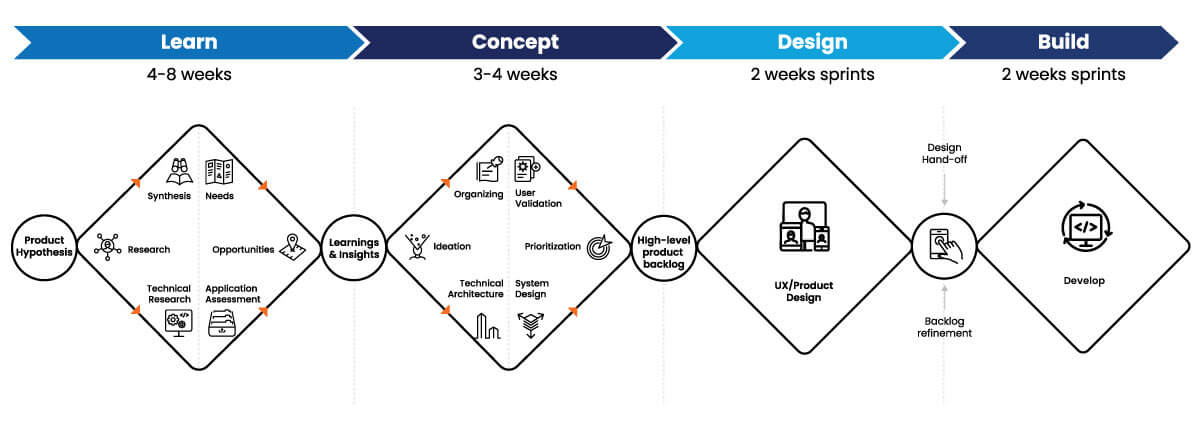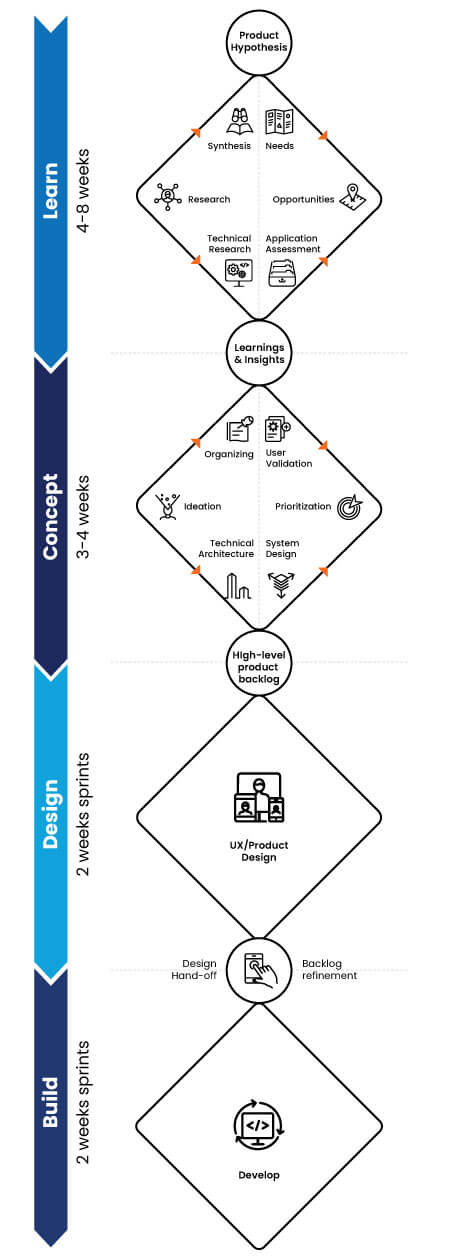Whether you’re looking for a partner to help you drive digital transformation within your organization or to simply help you deliver a mobile app, The Trianz Digital Studio is a digital experience consultancy that can help your organization at any point along the innovation or problem-solving life cycle. Built on the success of Trianz as a provider of customer-centric technology solutions, the Digital Studio merges our approach to design with the deep technical capabilities that Trianz has successfully demonstrated over the past couple of decades to create a methodology that can drive success for your needs within customer experience, employee experience, or innovation. A modular structure allows us to recommend appropriate design tactics, recognizing that every project is never the same.
Our methodology derives from our fundamental belief:
Engaging experiences are enabled by a profound understanding of and empathy for people.
This belief reinforces the principles of people-centered design which starts from learning about the end users of the product, exploring the problem space and only then to begin solutioning.
In this era of mashups, we’ve combined three frameworks to create the Digital Studio methodology: the British Design Council’s Double Diamond design framework, with its hallmark sequential divergent- convergent approach; the Design Thinking innovation framework, popularized by David Kelley; and the Scrum Agile methodology.
Double Diamond design framework
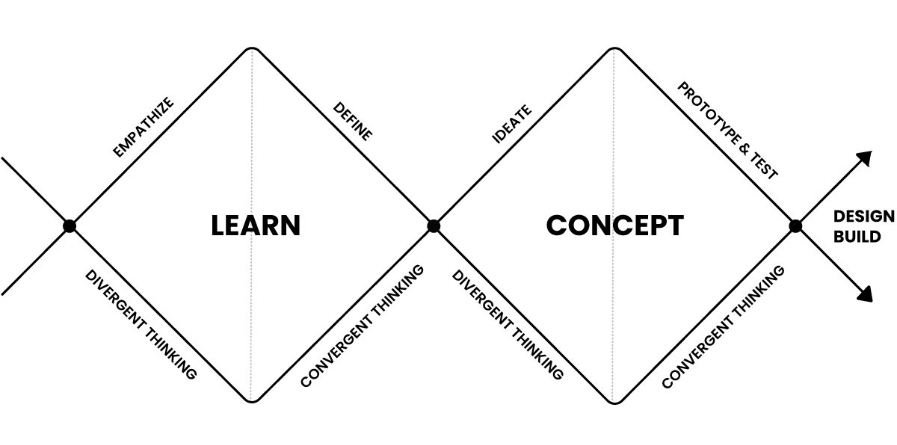
Our process consists of 4 diamonds strung together in to Learn, Concept, Design and Build phases. The journey through them helps shape an abstract or ambiguous problem into a user-validated product to achieve maximum business impact.
Phases of Trianz Digital Studio Methodology
The Learn Phase
The Learn Phase is about discovering the right problem to solve for – going from a general understanding of the problem to a specific problem statement. We’re also learning as much of the backstory as possible – how did we get here? What other approaches or attempts have been made? Who are all of the stakeholders? What constraints exist? And so on. For the agile practitioner, they’ll recognize this as the elaboration phase.
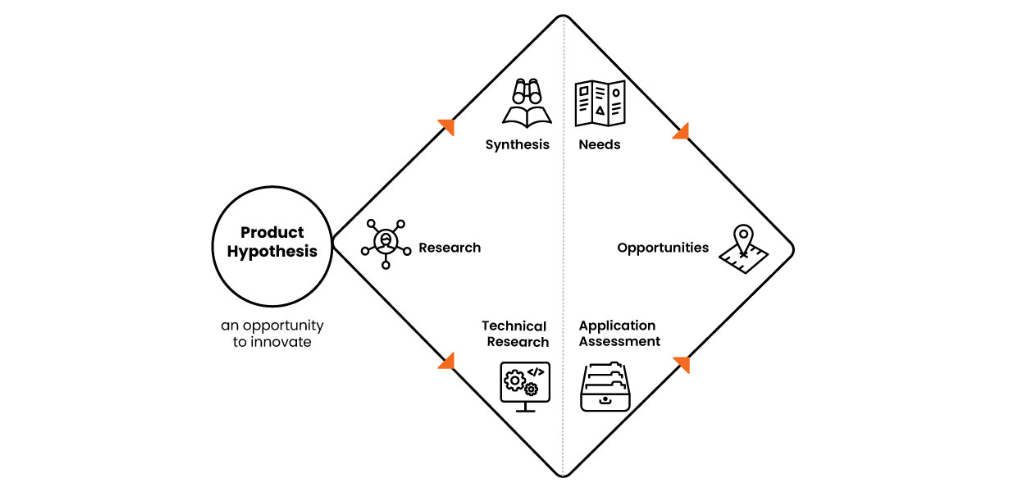
We start with a divergent-thinking approach, illustrated by the diverging lines of the first diamond; it represents an opening of the lens to allow as much information in as possible. Our concern at this early stage of the problem-solving process is to avoid fixating on what we think to be the problem. Many projects fail not because a beautiful solution proved elusive, but because the “solution” wasn’t to the right problem. Fully exploring the problem to gain a profound understanding is how we greatly improve our success rate and ROI.
Research is the primary activity in our divergent-thinking toolbox, including user research, ethnographic or time-motion studies, usability studies, competitive analysis, & stakeholder interviews. We’re interested in capturing both quantitative and qualitative data to build our understanding of the situation, the backstory, and the customer – and the customer can be a consumer, a business buyer, an internal customer or a supply chain partner; they’re all customers in our people-centered design approach. Our end goal is to create a view of the world from their vantage point – to understand what it’s like to walk in their shoes, so to speak. We want to understand not only what they are trying to do, but why, and what frames of mind they have when engaging with the product. Empathy is the key word: we want to empathize with the users.
Why do we go to such effort to empathize with customers? It’s why we exist as organizations; our purpose is to solve the problems of our customers. In the words of the great business thinker Peter Drucker, “the purpose of a business is to create a customer.” To do that effectively and efficiently, organizations must identify and solve their customers’ meaningful challenges while avoiding the distractions of creating solutions that solve no meaningful problem.
Now that we are at the apex of our understanding, we’ll traverse the downward slope of the Learn Phase diamond to converge at our problem definition. Taking the data and insights gained, we collaboratively synthesize a mental model of the problem to create a shared understanding of the customer and the problem space. We use tools like Clayton Christensen’s jobs-to-be-done framework to help us evaluate and articulate the various needs that arise in a customer’s life and to then map those to desired customer outcomes.
By the end of this phase we have defined the customer journey, user personas and/or a service-design blueprint that all provide a compelling picture of the problem space to you and your stakeholders. We are now able to assess the meaningful opportunities and then define the problem that is the most compelling and/or germane to the challenges at hand.
The Concept Phase
The Concept Phase is about fully exploring the solution space by using the same divergent-convergent approach to identify the best solution or direction to the Learn Phase’s problem statement. In this phase, however, we promise to engage your creative brain rather than the more logical-brain approach previously.
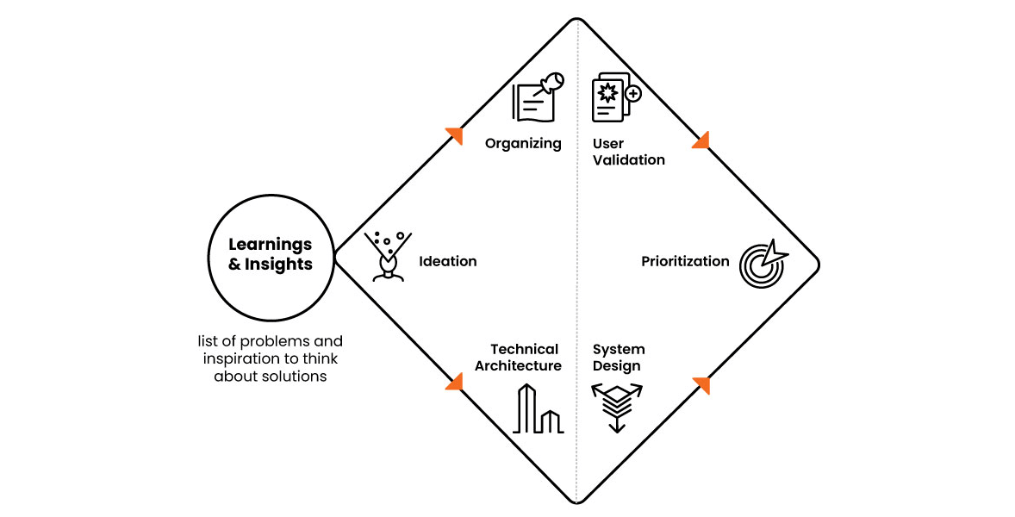
Ideation – a divergent-thinking process – is how we’ll begin exploring the solution space. Ideation is also a more creative process, so we’ll ask you to engage your creative brain with exercises that emphasize more visual, stylistic and imaginative mental processes in order to create outputs like mood boards and storyboards. Our goal is to quickly create high-quality mockups and high-resolution concepts that allow your team to visualize a final outcome. An interesting aspect of these ideation sessions is that with the plethora of collaboration tools on the market today, we have conducted these remotely/virtually as well as in person. Regardless of whether done virtually or in person, the collaborative ideation approach allows us to generate many ideas and to imagine a concept that forms the basis of our desired outcome.
We’ve ideated several possible directions, so we’re now ready to converge on the direction that best addresses the problem. Our convergent thinking will take the form of validating, prioritizing, removing, refining and sorting the various ideas. Our preferred tool at this point is the prototype – a visual representation of the product or service concept. Given that the bulk of our work involves digital experiences, these prototypes are usually in the form of a medium-to-high-fidelity mockup. The power of prototypes is the visual – and sometimes tangible – evidence they provide to stakeholders. People are so much better at seeing real examples when making decisions. In addition to stakeholder alignment, prototypes are key to early usability testing of new ideas.
Prototype in hand, we can now take our idea to real-world users to test our concept before moving on to the costlier aspects of engineering. The final concept helps determine the project priorities and is a starting point to create a product backlog. By the end of this phase we’ve done most of the heavy lifting by translating user behaviors, mental models, needs and technical capabilities into a concept that you and executives are ready to approve.
The Design Phase
The Design Phase is where the rubber meets the road – the product concept is going to be fully conceived in all its glory. We take an iterative approach, specifically scrum, to work with your stakeholders to flesh out each aspect of the design in recurring 2-week sprints to tackle the prioritized product backlog.
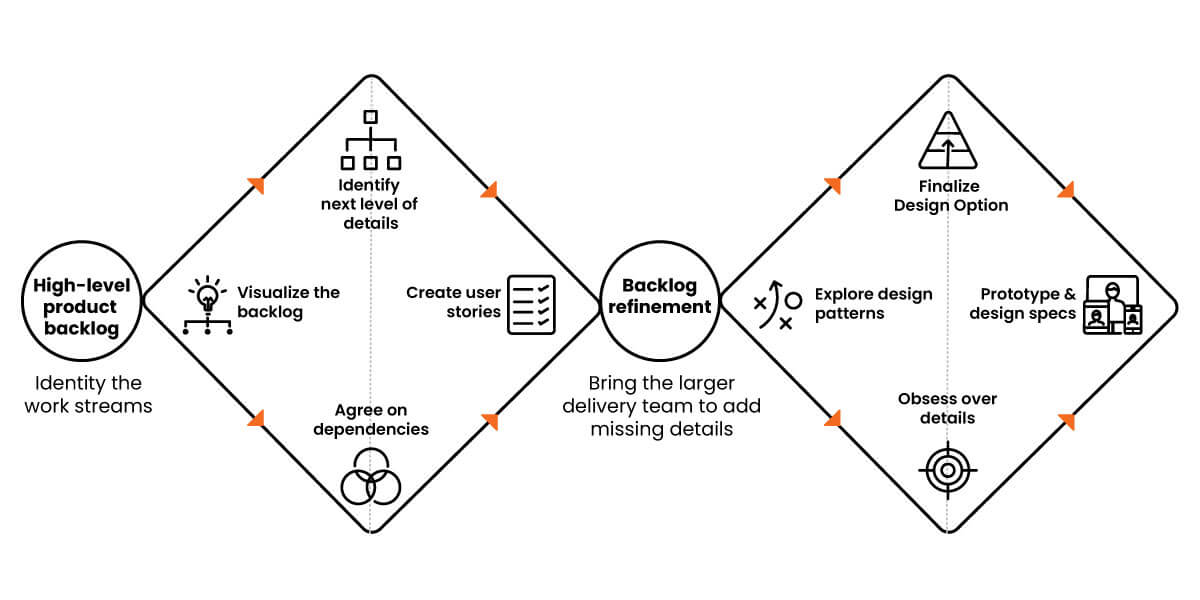
Now is the time we focus on details, edge cases, fun animations, iconography, illustrations, design systems, UI consistency, accessibility requirements, content strategy, and various device needs like mobile, desktop, wearables, or kiosks. We then conduct usability tests of the product using prototypes and fine tune the designs throughout this phase. The user focus shifts from asking why a user should use your product and what they want, toward asking and observing how they actually use and interact with the newly created designs.
The Build Phase
Finally, it’s time to actually start building something. In most cases the Build Phase will run in parallel to the Design Phase in staggered 2-week sprints, handing approved designs to the developers while working closely with them to ensure that designs are implemented to spec, answering their questions, and providing them with design assets. Our engineering teams have platform-specific knowledge and guide our design teams to exploit powerful features, widgets and design patterns to enhance the user experience while considering maintenance, performance and scalability of your product.
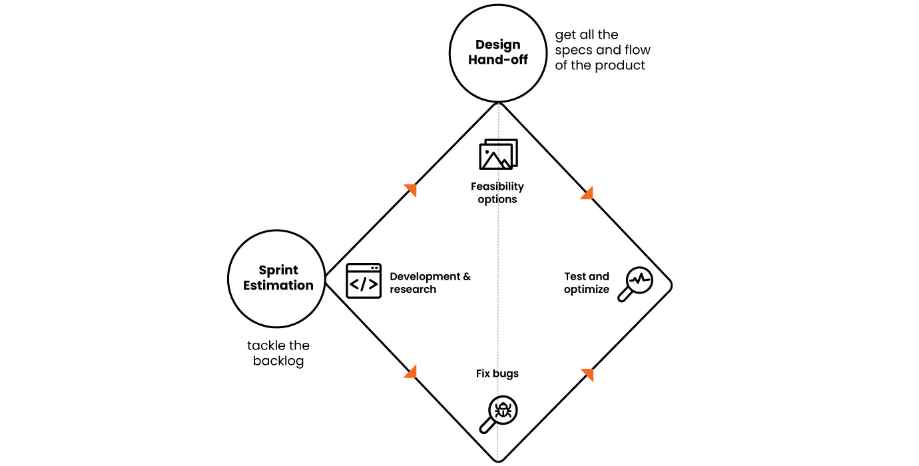
Our methodology leverages several important approaches to design and software delivery, but our success has a few other foundational elements, too. The success of projects requires a commitment to collaboration, open communications, and inclusion. We live in a global economy where the best ideas aren’t from the usual places – they come from the most unusual places. Breakthrough products require differing perspectives, so while our belief in the divergent-convergent approach of our methodology is strong, it’s only as good as the voices heard. Our global delivery model provides a key ingredient to that model of inclusive collaboration, but it also demands a commitment to collaboration, open communications, and inclusion.
Before you go, we want to ensure that you take away one last thought. We strongly believe in our Digital Studio methodology, but it is a starting point and it is flexible. In other words, we are neither dogmatic about it nor unable to adapt to the approach your teams are comfortable using. In our experience, every organization has created their own variant of how to deliver solutions in the enterprise. The only thing we are unwavering on is your success.

